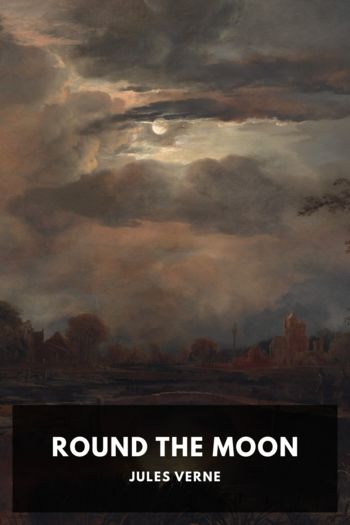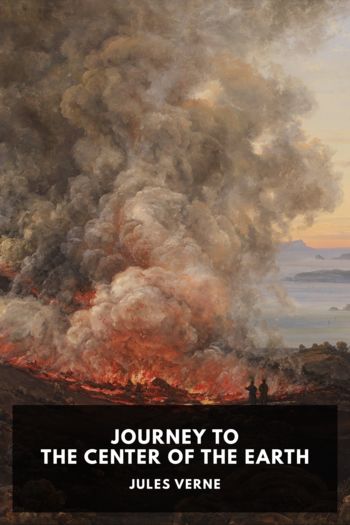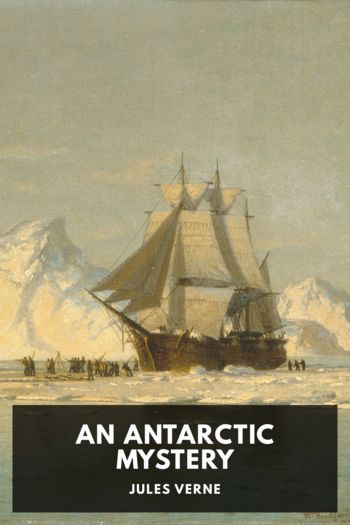Round the Moon by Jules Verne (read aloud txt) 📕

- Author: Jules Verne
Book online «Round the Moon by Jules Verne (read aloud txt) 📕». Author Jules Verne
“Ah!” exclaimed Michel Ardan, made enthusiastic by the sight, “what grand towns could be built in this circle of mountains! A tranquil city, a peaceful refuge, away from all human cares! How all misanthropes could live there, all haters of humanity, all those disgusted with social life!”
“All! It would be too small for them!” replied Barbicane simply.
XVIII Grave QuestionsIn the meantime the projectile had passed the neighbourhood of Tycho. Barbicane and his two friends then observed, with the most scrupulous attention, those brilliant radii which the celebrated mountain disperses so curiously on every horizon.
What was this radiating aureole? What geological phenomenon had caused those ardent beams? This question justly occupied Barbicane. Under his eyes, in every direction, ran luminous furrows, with raised banks and concave middle, some ten miles, others more than twenty miles wide. These shining trails ran in certain places at least 300 leagues from Tycho, and seemed to cover, especially towards the east, northeast, and north, half the southern hemisphere. One of these furrows stretched as far as the amphitheatre of Neander, situated on the 40th meridian. Another went rounding off through the Sea of Nectar and broke against the chain of the Pyrenees after a run of 400 leagues; others towards the west covered with a luminous network the Sea of Clouds and the Sea of Humours.
What was the origin of these shining rays running equally over plains and reliefs, however high? They all started from a common centre, the crater of Tycho. They emanated from it.
Herschel attributed their brilliant aspect to ancient streams of lava congealed by the cold, an opinion which has not been generally received. Other astronomers have seen in these inexplicable rays a kind of moraines, ranges of erratic blocks thrown out at the epoch of the formation of Tycho.
“And why should it not be so?” asked Nicholl of Barbicane, who rejected these different opinions at the same time that he related them.
“Because the regularity of these luminous lines, and the violence necessary to send them to such a distance, are inexplicable.
“Parbleu!” replied Michel Ardan. “I can easily explain to myself the origin of these rays.”
“Indeed,” said Barbicane.
“Yes,” resumed Michel. “Why should they not be the cracks caused by the shock of a bullet or a stone upon a pane of glass?”
“Good,” replied Barbicane, smiling; “and what hand would be powerful enough to hurl the stone that would produce such a shock?”
“A hand is not necessary,” answered Michel, who would not give in; “and as to the stone, let us say it is a comet.”
“Ah! comets?” exclaimed Barbicane; “those much-abused comets! My worthy Michel, your explanation is not bad, but your comet is not wanted. The shock might have come from the interior of the planet. A violent contraction of the lunar crust whilst cooling was enough to make that gigantic crack.”
“Contraction let it be—something like a lunar colic,” answered Michel Ardan.
“Besides,” added Barbicane, “that is also the opinion of an English savant, Nasmyth, and it seems to me to explain the radiation of these mountains sufficiently.”
“That Nasmyth was no fool!” answered Michel.
The travellers, who could never weary of such a spectacle, long admired the splendours of Tycho. Their projectile, bathed in that double irradiation of the sun and moon, must have appeared like a globe of fire. They had, therefore, suddenly passed from considerable cold to intense heat. Nature was thus preparing them to become Selenites.
To become Selenites! That idea again brought up the question of the habitability of the moon. After what they had seen, could the travellers solve it? Could they conclude for or against? Michel Ardan asked his two friends to give utterance to their opinion, and asked them outright if they thought that humanity and animality were represented in the lunar world.
“I think we cannot answer,” said Barbicane, “but in my opinion the question ought not to be stated in that form. I ask to be allowed to state it differently.”
“State it as you like,” answered Michel.
“This is it,” resumed Barbicane. “The problem is double, and requires a double solution. Is the moon habitable? Has it been inhabited?”
“Right,” said Nicholl. “Let us first see if the moon is habitable.”
“To tell the truth, I know nothing about it,” replied Michel.
“And I answer in the negative,” said Barbicane. “In her actual state, with her certainly very slight atmosphere, her seas mostly dried up, her insufficient water, her restricted vegetation, her abrupt alternations of heat and cold, her nights and days 354 hours long, the moon does not appear habitable to me, nor propitious to the development of the animal kingdom, nor sufficient for the needs of existence such as we understand it.”
“Agreed,” answered Nicholl; “but is not the moon habitable for beings differently organised to us?”
“That question is more difficult to answer,” replied Barbicane. “I will try to do it, however, but I ask Nicholl if movement seems to him the necessary result of existence, under no matter what organisation?”
“Without the slightest doubt,” answered Nicholl.
“Well, then, my worthy companion, my answer will be that we have seen the lunar continent at a distance of 500 yards, and that nothing appeared to be moving on the surface of the moon. The presence of no matter what form of humanity would be betrayed by appropriations, different constructions, or even ruins. What did we see? Everywhere the geological work of Nature, never the work of man. If, therefore, representatives of the animal kingdom exist upon the moon, they have taken refuge in those bottomless cavities which the eye cannot reach. And I cannot admit that either, for they would have left traces of their passage upon the plains which the atmosphere, however slight, covers. Now these traces are nowhere visible. Therefore





Comments (0)